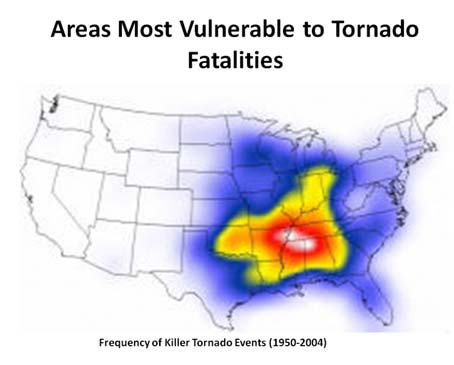Tornadoes are Right Up our Alley
April 17, 2018

Tennesseans must be prepared for tornado season, as the state is right in the middle of Dixie Alley.
The notorious Tornado Alley on the plains is a breeding ground for powerful tornadoes. It is not common knowledge that Tennessee is located within an area known as Dixie Alley. Unlike its cousin on the plains, Dixie Alley is regarded as the more deadly area. There are more fatalities during weather outbreaks in the southeast because the number of mobile homes is higher, the population is more closely packed together, and, oddly enough, a majority of tornadoes in the southeast are nocturnal. In fact, a 2005 study showed that, of the tornadoes in Tennessee, over 45.8 percent occurred between midnight and sunrise. Tennessee ranks third in the nation for average fatalities during its tornado seasons, just below Missouri and then Alabama.
Consequently, it is very important to know exactly what to do during a tornado or severe weather outbreak. Foremost, be sure to know exactly if there is a tornado warning or tornado watch. The main difference is that a warning is only issued if a tornado has been sighted in the area. A watch is issued if there are conditions that could possibly spawn a tornado. If there is a watch, be prepared. Check that that weather radios and flashlights have batteries, safe spots have blankets and pillows, and a plan has been made. Once a warning is in place, it is time to take action. A general rule of thumb is to create a safe spot in the lowest, most-interior room of a sturdy building. Avoid all windows, doors, and exterior walls. If you are in a mobile home, outdoors, or a vehicle, get to the closest substantial structure such as an overpass, or house.
In the event of an actual storm, be sure to bring pillows, blankets, pets, flashlights, and a weather radio. Go straight to the safe spot and create a padding between you and the storm with pillows and blankets. Although slightly ridiculous sounding, but actually effective, it would be advisable to bring some sort of off-roading helmet. The chief cause of death during a storm is impalement or blunt force trauma by flying debris. The helmet provides the most essential organ in the body an extra layer of protection.
After the tornado has passed, only go outside once the storm stops and the tornado warning has been lifted. Be cautious of any downed power lines. Assess the damage to your property and contact loved ones and friends.
Works Cited
NWS Tornado Safety Safety Home Page, et al. “NWS Tornado Safety Home Page.” NWS Tornado Safety Tips, NOAA’s National Weather Service, 1 Jan. 2001.
“Tornado-Related Fatalities – Five States, Southeastern United States, April 25–28, 2011.” Centers for Disease Control and Prevention, Centers for Disease Control and Prevention, 20 July 2012.


